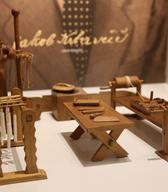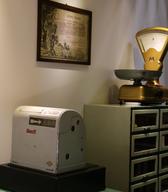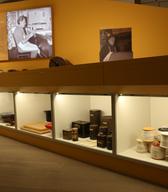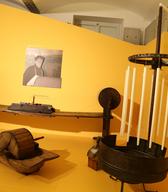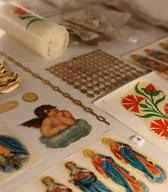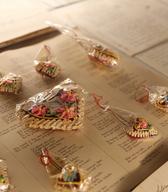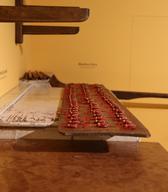Gingerbread making operates with small change
The exhibition presents the old gingerbread and the candle-making workshop and a shop, which used to be at Trubarjeva street in Ljubljana as well as their activities linked to the life story of the master craftsman Jakob Krbavčič and his son, who was his successor. The whole collection was acquired by the SEM twenty years ago. The exhibition complements the other two permanent exhibitions of the SEM thematically and substantively with the urban craftsmanship.
The exhibition is linked thematically and in terms of content to our permanent exhibitions Between Nature and Culture and I, We and Others – Images of My World, and is therefore conceived as their integral part. It complements them by exhibiting the materials related to an urban craft that has not yet been presented in our museum. Following the model of personal exhibitions organized in the museum, it depicts the interesting professional journey of those who practiced the craft, as well as their life stories.
The exhibition is divided into three parts:
1. Workshop
In addition to furniture, the workshop includes equipment, tools and craft products, as well as photographs of the members of the Krbavčič family (Jakob, Andrej, Darja and Ajda) engaged in candle making or the making of gingerbread in the workshop on Trubarjeva Street. In the display cases that mark the border of the workshop are various small tools and accessories, as well as candles and gingerbread products. Between the two rows of display cases is the central panel with a built-in screen on which the visitor can watch two short films. The first was made by Andrej Krbavčič in 1970 and shows his father Jakob Krbavčič at work. The other, made by Radio-Television Slovenia in 1986, presents Andrej Krbavčič making candles and gingerbread products in the family workshop.
2. The Candle Has Burned Down / Krbavčič's professional path and family story
Krbavčič's life story begins in the central, exposed showcase with the presentation of the gingerbread and candle makers working in the workshop on Trubarjeva Street. First, with a photographic portrait of Rajko Pečnik, Krbavčič's predecessor and mentor, and the clay pipe that he smoked right up to his death. The pipe was kept by Krbavčič in memory of the master craftsman who had taught him. Then there is a photograph from the early 1940s of Jakob Krbavčič with his wooden model of a candle-making workshop. The model and the pipe had been kept by Andrej Krbavčič as keepsakes, and were later handed over to the museum.
Krbavčič's story continues in the wall showcase displaying the adapted text written by his son Andrej, photographs, original documents and various objects, through which we follow the life of Jakob Krbavčič from his arrival in Ljubljana to his death. It is followed by an outline of the continuation of the craft and the story of Andrej Krbavčič up to the decline of the craft activity on Trubarjeva Street in the 1990s.
3. Shop
The shop in the exhibition is an approximation of the shop on Trubarjeva Street upon its closure in 1996. It contains cupboards and a sales counter. The cupboards with glass doors display gingerbread and candle-making products for sale, as well as various decorative products, which in situ gave the shop a well-ordered appearance. On the sales counter is the till, and the scales are placed on a small cupboard. The display cases that mark off the sales area contain products and small shop accessories, bags for biscuits and sweets, and gingerbread. The panels above show information about the shop and the way products were sold, photographs of the shop from different periods, and the plan of the shop fittings made in 1934.
The exhibition also includes reminiscences from Jakob, Aleš and Andrej Krbavčič about gingerbread and candle making, as well as about the family itself. The text for the brochure The Candle Has Burned Down was written by Andrej Krbavčič.
Material objects at the exhibition
Krbavčič's workshop and shop contain over 1000 objects, dating from the mid-eighteenth century up to the present. Most of the objects are from the
early twentieth century and the period between the two World Wars, whilst the candles and gingerbread products are mainly from the 1990s. The oldest item is an iron calibrated plate or mould from 1748, with punctured calibrations and the year of manufacture. The mould is part of a wooden pulling device with two drums and a small trough for wax, which was used to make drawn candles. The collection also contains a tub with a roller for whitening wax, and a device for making candles by pouring wax onto a wick. Of particular interest are objects for decorating candles, such as the tweezers, and brass and bone tools used for making different wax patterns on the candles. There are also various rollers for shaping candles, wooden candle-making knives, tinplate and plaster moulds, and more recent metal moulds. The collection includes other accessories and equipment, such as scales, a wax press, two cauldrons for melting wax, workbenches and drawers. There are also materials used in candle making: different kinds of wick, paraffin, wax, dyes, various printed pictures for decorating candles, and so on.
The objects used in gingerbread making are particularly rich and varied: wooden spoons, rollers, strainers, sieves, pestles and mortars, and dishes of various sizes, shapes and materials. There are metal moulds for shaping gingerbread and biscuits, known as šteherji in Slovene (depicting St Nicholas, Black Peter, hearts, geometric shapes; animal figures – horse, lamb, pig), baking trays and wooden boards on which to dry gingerbread. There is quite a diverse range of nozzles for decorating gingerbread with icing. The collection contains some old wooden honey-bread moulds.
The more recent moulds were made by Jakob Krbavčič himself. He enjoyed working with wood, and in addition to models also made some decorative items for the shop. It was he who carved the decorative image of the baby on the wall, which is based on a gingerbread mould, as well as some small decorative items for the shop window and interior. These show that Jakob Krbavčič had his artistic side, and he was a member of the Society of Artists for Applied Art in Ljubljana.
The exhibition also includes shop furniture from the 1930s and small items such as a till, scales, the signboard with the name of the craft above the entrance door and the house number sign.



